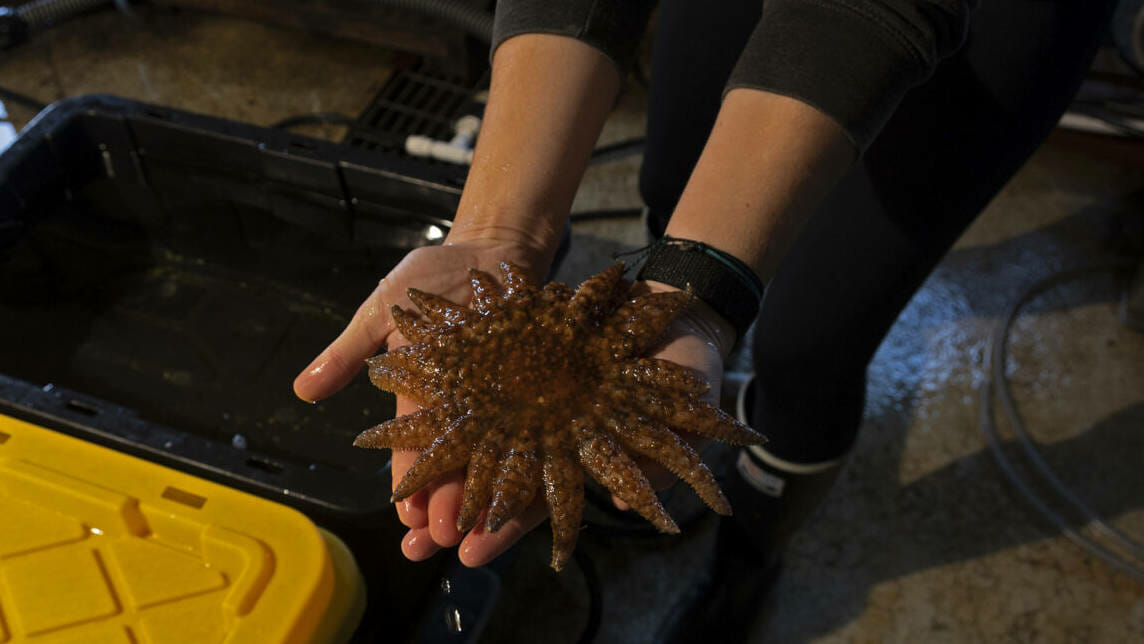
Set to a soundtrack of humming water pumps and bubbling sea water, Dr. Sarah Gravem’s research comes alive. But it’s not the high-tech science lab you might imagine. In the basement of the Sitka Sound Science Center, a collection of plastic tubs and barrels serve as control tanks, and researchers collect data by hand every few hours.
It’s within these unassuming tubs that our main character, the sea star, sheds light on the world of underwater forests.
Gravem, a postdoctoral scholar and marine ecologist from Oregon State University, is one of six researchers from Santa Cruz and Oregon working to understand the recent decline of Pacific kelp forests. She walks through the lab, exposing tiny underwater worlds.
“What we’re looking at right now is a bunch of laboratory experiments that we have running, looking at, for example, how fast the sunflower sea stars eat urchins and eat snails,” she said. “And then how fast the urchins and the snails eat kelp. And then over here is when you put them all together — how does the presence of the sea star benefit the kelp? And how does that change their behavior?”
From the coast of Mexico to the Gulf of Alaska, ocean habitats have seen a startling change over the last four years. Invisible from land, beneath the waves of the Pacific, kelp forests have been fighting a losing battle.
Scientists have taken notice as the once-thriving kelp forests and the ecosystems they support have become rocky wastelands.
“The Santa Cruz lab over the last few years has noticed that big, lush kelp forests full of kelp, full of other critters, fish, abalone, et cetera are disappearing and transitioning into urchin barrens, which are more bare rock,” Gravem said. “And a lot of sea urchins just cruising around and grazing all the algae down and preventing other things from using that algae as a place to live or thing to eat.”
Like their terrestrial counterparts, kelp forests rely on an intricate web of predators and prey: sea otters, urchins and starfish. On remote shores, that web remains intact. Closer to cities and towns, the system has been thrown out of balance. And kelp forests suffer.
“In Oregon, we’re just now seeing kelp starting to collapse,” Gravem said. “And we’re seeing inklings of it here up in Alaska, and we are hoping it’s not on its way.”
Gravem says the decline of sea stars could be one of the reasons it’s happening.
“They’ve been wiped out in Oregon, California, most of Washington, and they’re here in Sitka,” she said.
The sunflower sea star, an echinoderm known for its excessive size and numerous limbs, has been making a slow recovery in Sitka.
“They got wiped out pretty badly, but they’re starting to come back a bit. And so the sunflower sea stars are the top predator. And they eat sea urchins, and sea urchins eat kelp,” Gravem said.
But even as the population rebuilds, years of damage has already been done. Sea stars were wiped out by sea star wasting disease, a plague-like sickness causing lesions, body fragmentation and eventually death. It’s when these sea stars, who once played the top predators, died that scientists saw the biggest transitions in the kelp.
By observing the ways kelp, urchins and sunflower sea stars interact, Gravem and her colleagues hope to unravel the kelp’s decline.
Gravem lifts a sea star out of its mini habitat, a bright orange mass of spiny arms. I balk at the size of it, but she assures me this star, an adolescent by her account, is on the smaller end.
“We actually had to go all the way across Chatham Strait to get big ones,” she said, holding the glistening invertebrate up to the light. “They’re not close to town. And so these ones are medium size, and they can get like the size of an extra-large pizza. They can get really, really big.”
Gravem says humans have long stewarded our terrestrial habitat but have failed to notice subtle changes in the ocean. Losing kelp forests could have potentially devastating implications for coastal communities.
But for Gravem, the buckets and barrels in this dark basement lab hold hope for the future.
"light" - Google News
August 02, 2021 at 12:56AM
https://ift.tt/2V3OVVr
Sea stars shed light on kelp forests' decline - KTOO
"light" - Google News
https://ift.tt/2Wm8QLw
https://ift.tt/2Stbv5k
Bagikan Berita Ini















Elevated Hemp Solutions
ReplyDeleteCBD Multivitamin Gummies